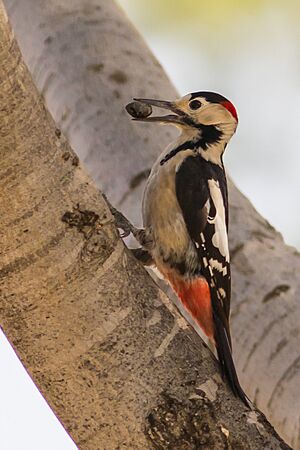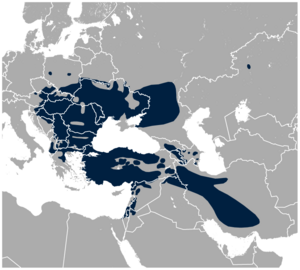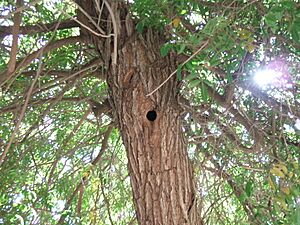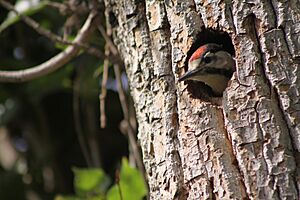Syrian woodpecker facts for kids
Quick facts for kids Syrian woodpecker |
|
|---|---|
 |
|
| Conservation status | |
| Scientific classification | |
| Genus: |
Dendrocopos
|
| Species: |
syriacus
|
 |
|
| Syrian Woodpecker range | |
The Syrian woodpecker (Dendrocopos syriacus) is a fascinating bird that belongs to the woodpecker family, called the Picidae. These birds are known for their strong beaks and their unique way of finding food.
Contents
Where Syrian Woodpeckers Live
The Syrian woodpecker is a bird that stays in one place all year round. You can find it breeding from southeastern Europe all the way east to Iran. In recent years, these birds have even started to spread further northwest into Europe!
They like to live in places with lots of trees. This includes open woodlands, farms with trees and bushes, and even parks. They need old trees for both finding food and building their nests. Even though they have bright colors, they can sometimes be hard to spot because they blend in with the trees.
What Syrian Woodpeckers Look Like
The Syrian woodpecker is about 23 centimeters (9 inches) long. It looks a lot like another bird called the great spotted woodpecker, Dendrocopos major.
Let's look at a male Syrian woodpecker:
- Its upper body is shiny black.
- It has a bright red spot on the back of its neck.
- Its forehead, the sides of its face, and its neck are white.
- There's a big white patch on its shoulder.
- Its flight feathers (the long feathers on its wings) are black with white spots. These spots form three white lines across its wings.
- The three outer tail feathers have only a few white spots. These spots show when the bird spreads its short, stiff tail, which helps it climb trees.
- Its belly is a creamy white color.
- The area under its tail is reddish.
- Its long beak is a dark gray, and its legs are greenish-gray.
Female Syrian woodpeckers do not have the red spot on their neck. Young woodpeckers also don't have this red spot, but their whole head is red!
It can be tricky to tell the Syrian woodpecker apart from the great spotted woodpecker. The Syrian woodpecker has a longer beak and more white on its head. It also doesn't have the white stripes on its tail that the great spotted woodpecker has.
How Syrian Woodpeckers Behave
Syrian woodpeckers have some interesting behaviors, especially when it comes to talking to each other and finding food.
Talking and Drumming
When a Syrian woodpecker is hidden by leaves, you might still know it's there because of its drumming! This is a fast, vibrating sound made by hitting its strong beak very quickly against a tree trunk or branch. It's not just a mating call or a challenge; both male and female woodpeckers do it.
You can hear this drumming from far away, depending on how windy it is and what kind of wood the bird is hitting. A hollow branch makes a louder sound than a living tree. The drumming of a Syrian woodpecker is usually longer than that of a great spotted woodpecker, and it gets quieter as it goes on. It's also faster and shorter than the drumming of a white-backed woodpecker.
Their call is a sharp "quit, quit" sound. It's softer than the call of a great spotted woodpecker and sounds a bit like a common redshank bird.
Finding Food
Syrian woodpeckers mostly eat insects that live inside trees. This includes the young (called larvae) of wood-boring moths and beetles. They also eat bees, like the Xylocopa pubescens.
A woodpecker usually lands on a tree trunk and works its way upwards. As it climbs, it taps the bark, breaking off small pieces. It often uses the tip of its sticky tongue to pull out its prey from cracks in the bark. When there aren't many insects around, they will also eat seeds, nuts, and berries.
Their movements are quick and jerky. They hop rather than climb, leaping forward with one foot just ahead of the other. They usually feed while facing upwards on a tree. However, it's not unusual for them to hang upside down, either vertically or horizontally, while looking for food. When they fly from one tree to another, their flight is smooth and wavy.
Sometimes, Syrian woodpeckers have been seen pecking holes in plastic irrigation pipes used for watering plants. The holes are usually small and round. The reason they do this is not fully understood.
Reproduction and Nests
Syrian woodpeckers make very neat, round nesting holes, about 5 centimeters (2 inches) wide. They bore these holes into soft or rotting wood. First, they dig horizontally for a short distance, then they dig straight down. At the bottom of this shaft, they dig a small room. This is where the female lays her eggs.
They lay up to 11 creamy white eggs directly on wood chips inside the nest. They rarely use the same hole again for nesting, but they often dig other holes in the same tree. Almost any tree that is rotten enough can be used for a nest.
When the parents are feeding their young, the baby birds gather at the opening of the hole and make a continuous chattering sound. But if they get scared, they quickly slip back inside the hole.
Images for kids






